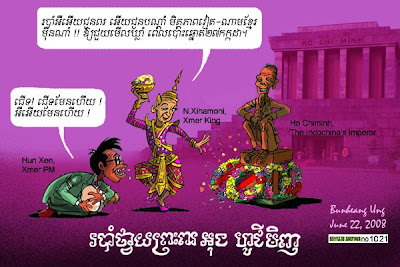PR-inside.com
2008-06-22
Number of international tourists arrival in Cambodia increasingly grow.
Tourism to Cambodia jumped more than 14 percent in the year to May, with Siem Reap posting the largest influx of foreign visitors, government figures show, although the Angkor temple town experienced a first-quarter dip in the number of arrivals from the same period in 2007.
Kong Sopheareak, director of the statistics department at the Ministry of Tourism, told the Post that Cambodia was on track to attract 2.3 million visitors this year, adding that political stability and infrastructure improvements had increased the number of tourist destinations in the country.
This diversification could be behind the seven percent drop in arrivals to Cambodia's most popular tourist draw, the Angkor temple town of Siem Reap, tourism officials said.
Elsewhere in Cambodia saw a significant surge in visitors, such as coastal resorts and the northeastern provinces of Mondulkiri and Ratanakkiri, according to Sopheareak, who added that tourism was hoped to earn Cambodia some $1.64 billion this year.
He dismissed concerns that the July 27 general election would impact the tourism sector, which is one of the few viable industries in the impoverished country.
Ho Vandy, president of Cambodia Association of Travel Agents, told the Post on June 10 that he too was optimistic that the polls would have little effect on arrival figures.
Cambodia's year-long political stalemate following general elections in 2003 had resulted in a 12 percent drop in visitors, he said.
Tourism is a fragile sector and if there is instability or unrest no tourists will want to come, so we hope all political parties will resolve any election issues peacefully,' he said.
South Koreans continue to make up the largest group of foreign visitors, followed by Vietnamese and then Japanese, according to tourism ministry figures.
Written by Nguon Sovan and Peter Olszewski
2008-06-22
Number of international tourists arrival in Cambodia increasingly grow.
Tourism to Cambodia jumped more than 14 percent in the year to May, with Siem Reap posting the largest influx of foreign visitors, government figures show, although the Angkor temple town experienced a first-quarter dip in the number of arrivals from the same period in 2007.
Kong Sopheareak, director of the statistics department at the Ministry of Tourism, told the Post that Cambodia was on track to attract 2.3 million visitors this year, adding that political stability and infrastructure improvements had increased the number of tourist destinations in the country.
This diversification could be behind the seven percent drop in arrivals to Cambodia's most popular tourist draw, the Angkor temple town of Siem Reap, tourism officials said.
Elsewhere in Cambodia saw a significant surge in visitors, such as coastal resorts and the northeastern provinces of Mondulkiri and Ratanakkiri, according to Sopheareak, who added that tourism was hoped to earn Cambodia some $1.64 billion this year.
He dismissed concerns that the July 27 general election would impact the tourism sector, which is one of the few viable industries in the impoverished country.
Ho Vandy, president of Cambodia Association of Travel Agents, told the Post on June 10 that he too was optimistic that the polls would have little effect on arrival figures.
Cambodia's year-long political stalemate following general elections in 2003 had resulted in a 12 percent drop in visitors, he said.
Tourism is a fragile sector and if there is instability or unrest no tourists will want to come, so we hope all political parties will resolve any election issues peacefully,' he said.
South Koreans continue to make up the largest group of foreign visitors, followed by Vietnamese and then Japanese, according to tourism ministry figures.
Written by Nguon Sovan and Peter Olszewski


